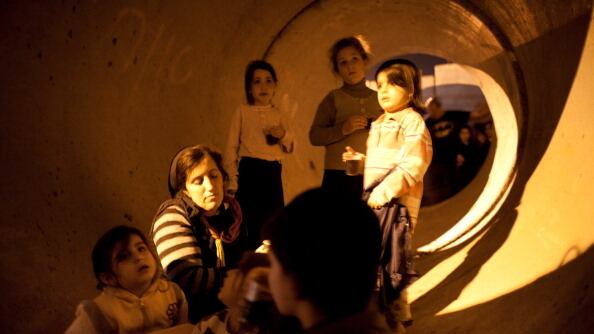I had the strange experience of flying toward Israel last Thursday, just after the war broke out. As I uttered my usual hope for an empty middle seat next to me, a friend speculated that businesspeople and tourists might cancel so many trips that my plane would be empty. Instead, the plane was full—filled disproportionately with youngish, mid-20s to mid-40-year-old Israeli men, many of whom, I imagined, would soon be turning in their t-shirts and jeans for combat fatigues and flak jackets.
Sure enough, as we landed, the first word I heard out of the first Israeli to make a phone call was the dreaded word “miluim,” reserves. And this Sunday, when I saw a feature in the Hebrew newspaper Yediot Achranot, using a new word I had never seen before, “miluimnikiot”—female reservists—who have received their “Tzav Shmona,” their call to duty, in record numbers, it seemed time to introduce Open Zion readers to some of the other words being used in this strange new war, wherein we know there will not be an old-fashioned conquest, nor an old-fashioned clear resolution.

Tzeva Adom/Az’akah—Tzeva Adom, which literally means “Red Color,” actually is translated as “Code Red,” a worldwide alarm for fire. When the az’akah (siren) goes off and ululates, it means there is a Code Red, incoming missiles. Sderot residents have 15 seconds to scramble, and then wait about ten minutes. In Southern Israel, the warning system originally broadcast a “Shachar Adom,’ a Red Dawn, until 2007, when a little girl Shachar, a popular children’s name, said it hurt her feelings. Red Dawn then became Code Red.
Teel/Teeleem—Missile or missiles, what we civilians call those deadly projectiles that traumatize en masse even if they kill a bit more selectively. More than 750 were launched from Gaza this year, bringing the total in eleven years to nearly ten thousand. Everyone watching this war closely has been learning to distinguish primitive, limited-range Kassams from more sophisticated, medium-range Katyushas and Grads to long-range, Iranian-made, Fajr-5 missiles, which Iran, of course, denied ever supplying to anyone from Gaza.
Tvach—Range, the new geographic marker in Israel. People ask if you live “betoch hatvach,” within range or “mechutz latvach,” outside—and of course Jerusalemites thought we were mechutz and learned after Friday’s az’akah (see above) we might be betoch.
Kippat Barzel—Perhaps this war’s cutest yet most anomalous term. A kippa is a headcovering, a yarmulke, which in my case covers a bald dome. Barzel is metal or iron, thus Kippat Barzel is Iron Dome, the missile defense system which is supposed to shoot down missiles heading toward civilian targets. Not to be confused with Kippat HaSela, the Dome of the Rock, or Kippat Hazahav, the Golden Dome—the two Hebrew names for Jerusalem’s Mosque of Omar, the magnificent, gilded dome that covers the rock from which Muhammad ascended to heaven, according to Muslim tradition, and which Jerusalemites thought kept them mechutz latvach.
Amud Annan—The name of this military operation, Pillar of Defense. Hebraists will want to shout "gotcha" at my mistranslation but that will show they haven't been watching the news. Annan is cloud in Hebrew so this army operation, amud annan, should be Pillar of Cloud. Instead, it is operation Pillar of Defense in English, emphasizing that it is a defensive war, entered into reluctantly, only as a last resort. I hope the Hebrew term Pillar of Cloud is not foreshadowing much smoke signaling mass destruction or a foggy ending guaranteeing yet another conflict four years from now.
Peulah Karkait—A ground war, literally ground action. The next move Israel is threatening to make, and the international community is trying to avert. Although, morally, how bombing from above is somehow more humane than invading is beyond me.
Hafsakat Esh—A ceasefire. That which we hope occurs soon, although in school a “hafsakah” connotes a far too temporary, regularly scheduled break, rather than, what I wish for, the cessation of hostilities.
Oref—The homefront, although literally, the back of the neck, the nape. This part of the body is particularly vulnerable, but also is the top of the spine, symbol of unbending strength and forthrightness.
Shigra—The routine, that which Jerusalemites and those mechutz latvach quickly returned to, and that which Israelis in the South crave to have.
Shalom/Salaam—Peace, easily said and understood, in both Hebrew and Arabic. Yet, alas, so difficult to achieve.






